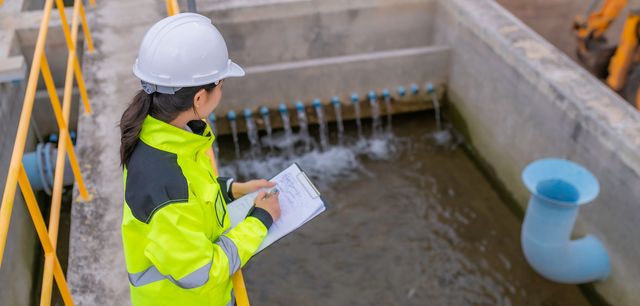17 July 2025
Even though the water in streams and rivers may look clean, almost every water body in Germany is contaminated with residues of medicines, cosmetics and pesticides. These trace substances not only cause problems for aquatic organisms but also accumulate in the groundwater which feeds into our drinking water supply. Today’s methods are not capable of filtering these pollutants out of the water. To do this, wastewater treatment plants need a fourth purification stage, which the EU is set to make mandatory.
The Hessian Ried, a low-lying agricultural area in central western Germany, is in trouble. This is because the rivers, streams and lakes of what once used to be marshland are heavily polluted with micropollutants: Residues of medicines, cosmetics, pesticides, cleaning agents and antifreeze. These trace substances are so called because they are found in concentrations no greater than one billionth to one millionth of a gramme per litre of river water. These may be unimaginably small quantities, but they still have serious consequences for aquatic animals. The painkiller diclofenac, for example, which is contained in the kinds of pain-relief gels found in every second medicine cabinet, can cause massive damage to the liver and kidneys of fish. And diclofenac is only one of over 1,300 substances in wastewater that are known to be hazardous. In some cases, it is not even the chemical itself that is problematic but the products of its degradation process.
Species loss due to wastewater
In a large-scale study, researchers at the University of Frankfurt demonstrated a loss of species at 170 wastewater treatment plants in the state of Hesse: Of the species flourishing in the water upstream of the sewage treatment plants, they found that 62 percent had disappeared subsequent to the discharge of wastewater from the sewage treatment plants.
The issue here is that the trace substances are highly soluble in water and poorly biodegradable. It therefore follows that they cannot be filtered out of the water using conventional methods. And their negative impact is not limited to the reproduction, development and growth of fish, snails and freshwater shrimps: These substances are also increasingly being found in groundwater. “In this respect, this poses an ever greater threat, ultimately also to our water resources and water quality,” said ecotoxicologist Jörg Oehlmann to broadcaster Hessischer Rundfunk. The researcher from Goethe University Frankfurt and his team are investigating the water quality of rivers in the state of Hesse. And this is a particularly crucial issue in the Hessian Ried, because the area is home to the largest groundwater reservoir in the state and supplies drinking water for around two million people – almost a quarter of all Hessians, in other words.
Deploying activated carbon against trace substances
This is why the Bickenbach wastewater treatment plant, which is located in the Ried, has added another stage to the three treatment stages (see box) customary in sewage plants. In this fourth treatment stage, the wastewater is first of all pre-filtered. It is then treated with ozone to oxidize the trace substances. The resulting degradation products and the trace substances that do not react to ozone are then tackled using activated carbon. The large surface area of the very finely ground activated carbon mean that the trace substances adhere particularly well, subsequently being either biodegraded or bound like a sponge and then removed with the sewage sludge.
This allows over 80 percent of the substances to be extracted from the water. Not only that, but phosphorus and nitrogen contamination is also further reduced. According to the local authority, this makes Bickenbach the most advanced and efficient wastewater treatment plant in the whole of Hesse. And with its fourth purification stage, it is the third of its kind in the state.
Making expansion mandatory in the EU
But whereas Switzerland introduced a mandatory fourth stage requirement in 2016, projects such as the one in Bickenbach have been implemented in the European Union on a voluntary basis and supported by subsidies. In the meantime, the EU has made some improvements. As laid down by the amended EU Municipal Wastewater Directive (known in Germany by the acronym of “KARL”) the largest wastewater treatment plants will have to be retrofitted with a fourth stage by 2045. According to the Federal Environment Agency (UBA), this affects 155 sewage treatment plants. Smaller sewage treatment plants will have to be retrofitted if they are located in risk areas, such as those where drinking water is extracted. According to UBA experts, this affects about 580 to 600 sewage treatment plants.
So far, however, only 61 sewage treatment plants in Germany have reached level four, most of them in Baden-Württemberg and North Rhine-Westphalia. Expansion is planned for a further 71. The fact that things are progressing so slowly is primarily down to the costs. In Bickenbach, the construction cost around ten million euros, one half of which has been borne by the state, the other to be paid for by the local authorities. Added to this are the high operating costs: After all, the fourth purification stage requires a particularly large amount of energy.
According to a study carried out by Germany’s Association of Municipal Enterprises (VKU), the expansion and operation of the additional treatment stages in Germany will cost almost nine billion euros by 2045. To ensure that these costs are not passed on to the consumers alone, the EU has now enacted the new Wastewater Directive to make manufacturers responsible for paying their fair share: In the future, producers of pharmaceuticals and cosmetics will have to pay 80 percent of the costs of the expansion and operation of the fourth purification stage. The member states will have to have transposed the directive into national law by the end of 2027, and producer responsibility will then take effect at the end of 2028.
© Adobe StockPollutants also accumulate in groundwater. With the new, fourth purification stage, wastewater treatment plants can filter out more than 80 per cent of harmful substances.
© Adobe StockUnspoilt nature? Not necessarily. The smallest trace substances pollute almost every body of water in Germany.
Conflict over KARL
Municipal associations celebrated the new directive as a milestone in European water policy. If implemented correctly, producer responsibility will relieve the burden on wastewater customers' wallets and ensure that manufacturers increasingly turn to products that cause less water pollution, the VKU found.
The pharmaceutical industry, however, is mobilising against the directive. Several pharmaceutical companies filed a lawsuit against KARL with the General Court of the European Union in March. Their argument: The trace elements in the waters are not solely due to human medicines or cosmetics. The pharmaceutical firms are not therefore the sole polluters, meaning that it would be unreasonable to force them to bear the costs of the fourth purification stage. Not only this, but the additional expense would mean that it would become impossible to produce a wide range of medicines in Europe in a cost-effective manner.
The German Association of Cities and other municipal associations have a counter argument, however, which is that it will be impossible to achieve the expansion demanded by Brussels without the participation of the manufacturers. In order not to delay the expansion and to give sewage treatment plant operators planning security, they maintain that producer responsibility must be quickly implemented into national law.
Species comeback in the Geräthsbach
Even as the wrangling over KARL continues, it is already becoming clear that the fourth stage is working, as scientific scrutiny of the Geräthsbach in the Hessian Ried shows. This stream receives wastewater discharges from the Mörfelden-Walldorf sewage treatment plant, which introduced a fourth stage in 2023. In just these two years, the fertility of the organisms in the Geräthsbach has improved, as the team led by researcher Jörg Oehlmann has discovered. And many sensitive species have returned in significant numbers.
In other words, the ecosystem is slowly starting to recover. But it is taking time for the community below the water surface to adjust to the improved conditions. This is because, importantly, the water from the Langen sewage treatment plant also flows into the Geräthsbach. And this plant does not have a fourth purification stage. At least not yet: In March 2025, the state of Hesse approved funding to the tune of ten million euros for a fourth stage, which is scheduled to go into operation in 2028, to ensure noticeably lower levels of trace substances in the Geräthsbach.
Today’s three stages of wastewater treatment
1. Mechanical cleaning – raking out the coarsest material
First of all, it’s important to extract the coarsest impurities from the wastewater. Shreds of paper, faeces, food residues and sand are filtered out with rakes into settling basins so that they cannot clog up the plant’s pumps. This primary sludge then travels on to digesters, where methane is extracted which is used to generate electricity and heat in combined heat and power plants.
2. Biological cleaning – by an armada of microscopic cleaning organisms
Once the coarsest material has been removed, the wastewater now continues its journey on to the aeration basin. This is where the activated sludge – a mixture of bacteria, fungi, protozoa and sludge – awaits. These microorganisms “devour” organic substances such as proteins, fats and sugars and convert them into biomass. Some of the bacteria also break down nitrogen compounds. For the microscopic cleaning armada to work effectively, the water in the aeration tank is enriched with oxygen. The living sludge then settles in the secondary clarifier and is largely discharged into aeration tanks, where the next feast awaits the microorganisms. The wastewater flows on to chemical cleaning.
3. Dry cleaning – precipitating phosphates
In this stage, phosphates and other chemical residues are tackled. With special agents such as iron chloride or aluminium sulphate, these substances dissolved in the water are “precipitated” – solidified and separated as sludge particles. This stage is particularly important to prevent over-fertilisation, which can result in sudden and catastrophic changes of water condition due to a lack of oxygen. In industrial sewage treatment plants, heavy metals, salts and other problematic substances are also removed in this stage.





